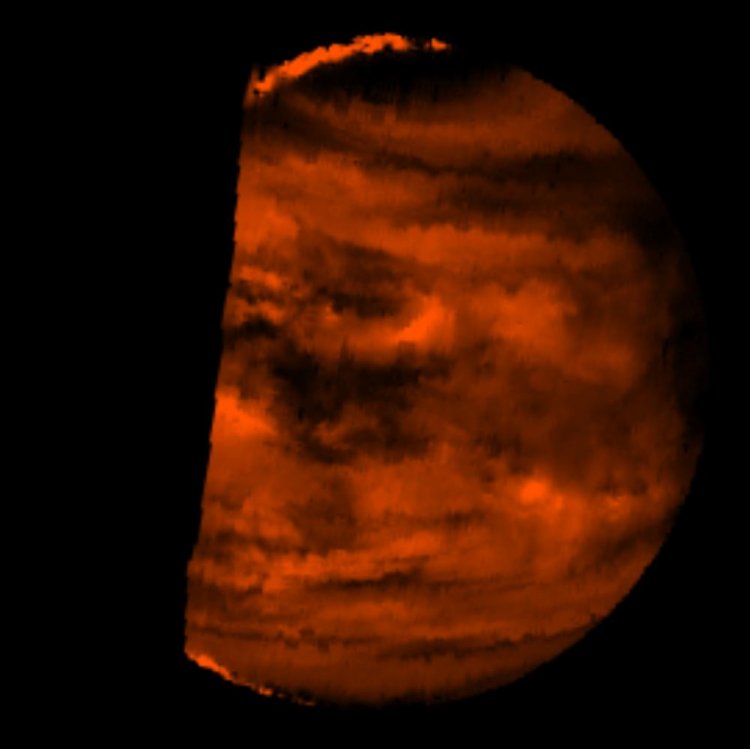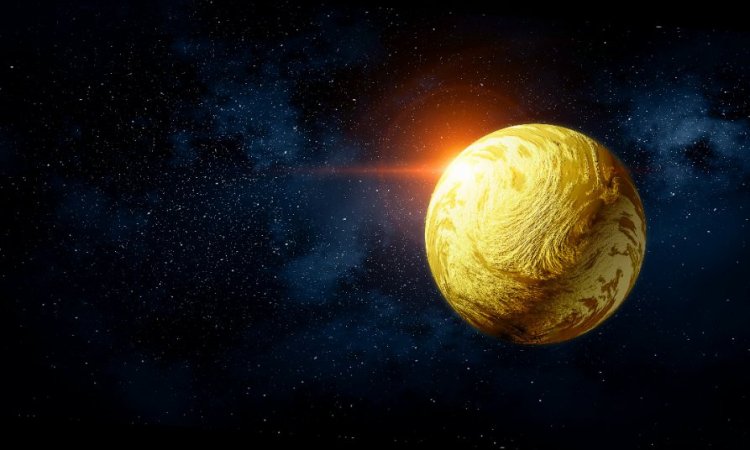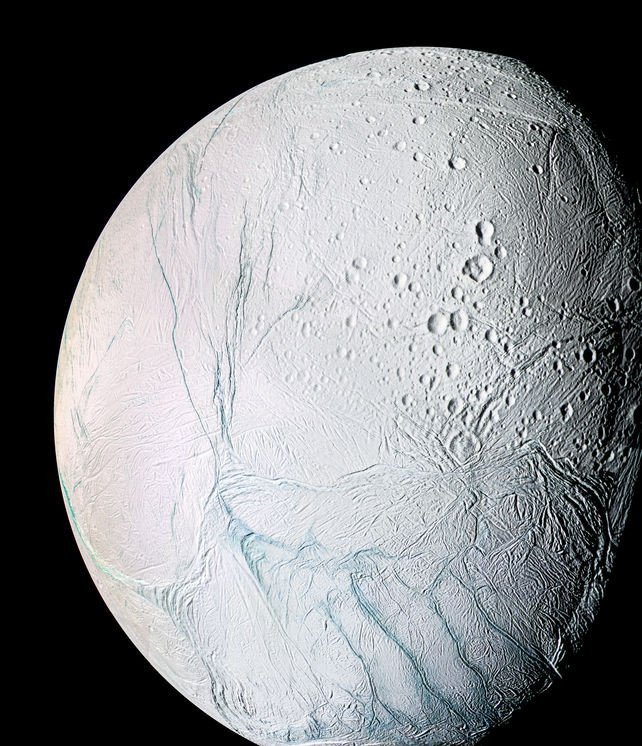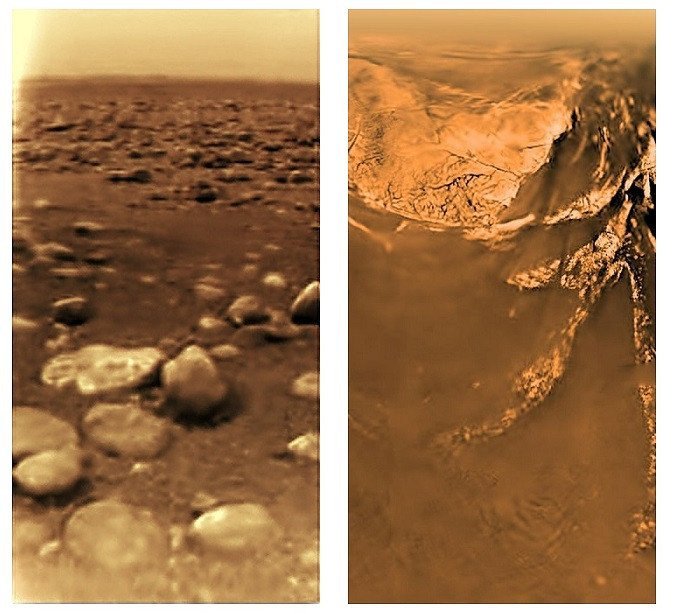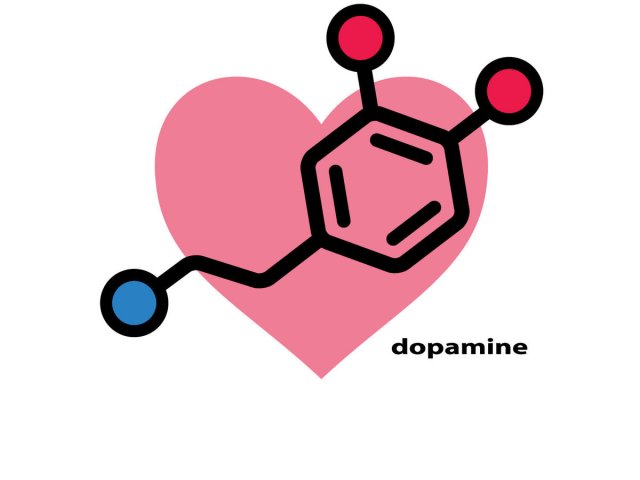Disappearing islands, methane circulation, and snow falling upward are just some rare natural phenomena that exist in our Solar System.
Junior researcher of the Astro Space Center (ASC) of the Lebedev Physical Institute of the Russian Academy of Sciences (LPI RAS) Vyacheslav Avdeev describes the most unusual extraterrestrial oceans and the search for water on the closest planets and their moons.
Vyacheslav Yuryevich Avdeev is a junior researcher of the ASC of LPI RAS (Laboratory of Mathematical Methods), science communicator, and the creator and host of the Shklovsky Street YouTube channel.
― Let us first talk about our closest neighbors, Venus and Mars. Have these planets ever had oceans?
― Both Venus and Mars used to have a lot of water. Traces of ancient riverbeds were found on Mars back in 1971. Probably, rivers had been flowing on the surface of Mars for thousands or even millions of years. Now there are no rivers there, of course. Besides, we have found river deltas on Mars. I mean areas where an ancient river flowed into a larger body of water, maybe a lake, sea, or ocean. However, there is more to come. Mars most likely had a huge salty ocean about 4 billion years ago! It was located in the northern hemisphere of this planet and was only slightly inferior to our Arctic Ocean in terms of the volume of water. It was quite large given the small size of the Red Planet. However, about 3.5 billion years ago, Mars began to lose its atmosphere, its climate became colder, water began to partially evaporate and partially freeze, so the planet gradually turned into what we see now. We can only guess when exactly Mars lost its atmosphere, scientists name different dates.
― Is it true that we can find water ice under the Martian sands?
― Yes, it is. Talking about its relief, it is especially interesting to note that even traces of a tsunami were found on Mars! Apparently, when meteorites fell on the planet, the water would rise, hit the coast, and then recede. Thus, they, among all else, found traces of two tsunamis that occurred when the climate on Mars had already become much colder. Those tsunamis went their own ways: one wave would be gone, while the other would freeze before it was gone. The frozen water formed ice masses, which scientists can obverse at that place. Now, when studying Mars from orbit and trying to probe its soil, we notice a so-called cryosphere, large storage of salty water, under the red sands of Mars. The soil contains up to 35% of this frozen water in some regions of Mars. If we scoop up Martian soil, we will see that this soil is nothing but wet sand.
― How deep is the Martian ice?
― The depth is actually not very significant. You will see this ice if you dig the soil just once or twice. You can also see it when meteorites fall on the planet. It is also important that Mars is covered with ice unevenly: its amount grows as it approaches the poles and decreases near the equator. Overall, we can say that there is water on Mars and it will be enough of it even to colonize the planet. However, there is another problem here, that is, where to get the atmosphere. I believe that the well-known approach proposed by Elon Musk — to detonate bombs to melt the polar caps of Mars — will be ineffective. The power of the bombs and the reserves of volatile substances in the polar caps of Mars will be insufficient. Probably, we will have to bring atmosphere to Mars from outside, for example, from comets.
― And what about Venus, the so-called Earth’s twin?
― Unlike Mars, we know very little about Venus. We know that the surface of this planet is very young: it almost completely renewed about 500-700 million years ago. At that time, the surface of Venus was covered with lava that hardened later, of course, so it is difficult to talk about ancient Venus. As we know, Soviet spacecraft once landed on the surface of the planet, but, unfortunately, they worked for a short time: no more than an hour and a half. Yes, we obtained good images and measured soil density, we even managed to drill it, but, alas, this time was insufficient to conduct a comprehensive study.
NIR (2.3 µm) image of the atmosphere on Venus obtained by the Galileo probe. Photo source: NASA / JPL
When studying the composition of the atmosphere on Venus, scientists compared the ratio of hydrogen isotope and deuterium, that is, heavy hydrogen. It turned out that this ratio was very different from what we have on the Earth. Our planet and Venus are relatives: they formed from the same gas-dust cloud, and, theoretically, the isotopic water composition of these two planets should be similar, but it is not true. Scientists began wondering as to how this difference in the ratio of isotopes could be explained and what the development scenario was. Venus had water, but the planet warmed up and its seas boiled away. As the water molecules rose higher, the solar ultraviolet broke them down into oxygen and hydrogen. Oxygen could then combine with some Venusian rocks, and hydrogen, which is very light, could dissipate (scatter. – Editor’s note) into space under the impact of solar wind and temperature. Venus was losing ordinary hydrogen faster than heavy hydrogen. The assumption that the initial isotope ratio was the same as on the Earth helped to estimate the amount of water lost. Using these data, scientists conducted research to find out that 60% of the surface of Venus could be covered with oceans. The Venusian ocean could be as deep as a five-story building. This is just what you need for a comfortable stay: a shallow warm ocean is much preferable to deep cold waters. As we know, marine organisms love very warm and shallow waters. However, all these assumptions about Venusian oceans are still mere hypotheses. It would be nice to test our assumptions by sending spacecrafts to Venus and making them work longer on Venusian tesserae (Venus relief elements that resemble parquet or tiles. – Editor’s note). The tesserae are sometimes erroneously called “continents,” but actually they are regions of Venus that are considered older than the lava-covered areas. The existence of an ancient ocean on Venus is quite possible, but, as I have already told you, we need further research. By the way, if that ancient Venus had rotated the way it does now, its entire ocean would not have boiled away. We know that the greenhouse effect on Venus is self-sustaining, it reinforces itself. Nonetheless, if an atmosphere like ours is pumped onto Venus, there will be no greenhouse effect as Venus will warm up very actively on its sunny side and intensely give off the heat on its night side. The reason is that Venus has a 243-day period of rotation on its axis, which means that it rotates very slowly. Scientists used climate models to estimate what one has to do about Venus to trigger its self-sustaining greenhouse effect. They found out that for this purpose the planet has to rotate much faster: one day has to last less than 20 Earth days. Now Venus rotates more slowly. The main question today is of what has happened to Venus, why its surface used to be covered with lava, why this planet rotates in the opposite direction, and why this rotation is so slow. I hope that future space missions will provide answers.
We can see a triple sunrise and sunset on Mercury.
Photo source: nexusplexus / 123RF
― Mercury is the closest planet to the Sun, so, probably, it is no use talking about the presence of water there, right?
― Mercury is closest to the Sun, but it is still cooler than Venus, as it has no atmosphere and no greenhouse effect. Days are very long on this planet, one day equals 59 Earth days, while the Sun illuminates Mercury from all sides. Mercury’s orbit is very elongated, which, together with the slow rotation of this planet around its axis, leads to very interesting effects. For example, if we watched the sunrise on Mercury, we would see several sunrises instead of one as we see on the Earth! This means that the Sun rises, then it sets, then it rises again, and it happens several times. By the way, Mercury has areas that are practically unilluminated by our star: they are deep craters in the polar regions where remote measurements have helped to find water ice reserves. Of course, they cannot be called “an ocean.” Water has never been liquid on Mercury and it cannot be liquid there at all, as this planet does not have (and has never had) an atmosphere. The Sun is very close to Mercury, it is too hot, while the solar wind has a very strong impact on this small planet.
― Is water a common phenomenon in the Solar System?
― It is not uncommon, as water has a very simple molecule: it consists of oxygen which is very widespread in our Universe, and hydrogen, the prevailing element. Water is found on planets and their moons, in interstellar clouds, on comets, and even around stars, both young and dying. The NASA James Webb telescope is now exploring water in the Solar System, and the LPI RAS Millimetron project will deal with the same research. Millimetron will study water distribution in protoplanetary disks. Such studies are very important, as this water distribution influences what type of a planet there will be in the long run.
It is noteworthy that the farther we go from the Sun, the more water we observe. An example is Jupiter’s moons. Probably its best-known moon is Europa, an ice ball that is slightly smaller than our moon. Apparently, there is a liquid ocean under Europa’s ice, and this ball does not freeze for several reasons: Europa’s orbit is slightly elongated, and its axis is tilted, therefore, heat is released due to tidal effects from Jupiter. Besides, there may be some substances in the water that prevent the ocean from freezing.
― What is the assumed composition of this water?
― Water molecules are always the same, they comprise oxygen and hydrogen, but it is also important what impurities Europa’s salty ocean contains. This is yet to be explored.
In 2018, the Nature journal published an article about complex organic compounds found on Enceladus. The same year, in their laboratory, Vienna scientists recreated conditions similar to those that exist on this icy moon of Saturn. Using the archaea Methanothermococcus okinawensis as an example, they demonstrated that terrestrial organisms can survive on Enceladus. Photo source: ivanzkart / 123RF
Europa’s ice layer is about 30 km, there is up to 100 km of water under it, and then a silicate core begins. One has to somehow drill the 30 km of ice to study the water on Europa. For example, there was an idea to penetrate this ice through an explosion, but such a powerful hydrogen bomb does not exist on the Earth. Even if we blow up all the bombs available on the Earth, we will most likely fail to create a hole in this ice layer. There is another, more humane approach, which is to study the composition of the geysers that appear on Europa from time to time. Under this scenario, there is no need to drill the ice, it will be enough to fly through such a geyser, collect water and see what it consists of. Thus, the Cassini probe, for example, flew through the ice plumes of Enceladus (Saturn’s moon) many times and managed to study the composition of this water, although this study was not very detailed. It turned out that this water contains some simple organic matter. Obviously, the ocean of Enceladus interacts with the planet’s subsurface and is rich in chemicals. However, a more detailed study needs more powerful equipment. As for Europa, at least two projects will be launched to explore it in 2023: the NASA Europa Clipper and the European Space Agency’s JUICE. The JUICE will first orbit Jupiter and approach Europa twice before it moves to the orbit around the largest moon in the Solar System, Ganymede.
― Ganymede is as interesting as the aforementioned Solar System objects in terms of water studies, isn’t it?
― Yes, it is. We assume that Ganymede also has an ocean, and this ocean is very unusual. Models show that the ocean of Ganymede looks like a layer cake: the top layer is made of ice, the next layer is water, the third layer is ice with a different structure (it forms at high pressures), then comes another layer of water, but it is saltier, then we see a layer of so-called hot ice, it is followed by a layer of water and, finally, we find the last layer of ice that probably borders on the silicate part of the moon.
Interestingly, the top layer, that is, the very first ocean of Ganymede, features such a phenomenon as anti-snow or snow that falls upward. Just imagine that we are in a submarine in the upper ocean of Ganymede. The water sometimes begins to freeze in this ocean layer, but the formed ice floes are less dense than the surrounding saline water solution, so they rise to the top, slowly drift, and settle in the top ice layer. However, we still do not know how stable all these layers of Ganymede ice are, whether they can interact with each other, crack, and so on.
― Let us finally recall another unusual object in our Solar System, that is, Saturn’s moon Titan. When I first saw images from the surface of this celestial body, I was very surprised to find out that the landscapes of Titan are similar to those of the Earth. The same coasts, stones hewn with water, rivers...
― Scientists have been exploring Titan since 1655, but it was not until 2004, when the Cassini-Huygens probe flew into the Saturn system, that we first saw images from the surface of this unusual moon. The Huygens space probe was specifically designed to explore Titan. It faced some problems with a program code during its mission, so the device transmitted only some portion of the information, but even this turned out to be very useful. What interesting findings did we see there? For example, wet sand is like that on our Earth but this sand is composed of quite hard water ice rather than silicates. We saw rounded stones that look like river pebbles, as well as river beds, lakes, and seas with liquid hydrocarbons: methane, ethane, and so on.
Titan’s landscapes. Photo source: NASA
Titan is really interesting. Suffice to mention the rains on this moon of Saturn! Titan’s gravity is seven times lower than that of the Earth, while its atmosphere is one and a half times denser, so the rains on Titan contain large drops that fall down very slowly to flow into streams, rivers, and seas. Thus, we can observe a fluid circulation here, but the liquid on Titan is not water, but methane, that is, the gas that we burn in our furnaces. It becomes liquid at -180°C. Besides, Titan has mountains and, what is interesting, the rocks are mainly composed of water ice with a layer of water and, then, silicates under it. There is an ocean of liquid water under Titan’s ice, but I do not think that there is life in it. Another interesting phenomenon is the disappearing islands of Titan. Just imagine a spacecraft flying over Titan that sees an island in the sea. However, this island does not exist during its next flight. Then, during the third flight, this island may reappear, but its shape will change. Is that really possible?
― Are they submerged in water?
― Maybe. We are not sure at the moment. There was even an assumption that Titan’s oceans are similar to soda in their properties. When we drop something into sparkling water, it starts to fizz. The same phenomenon can happen on Titan where, according to one of the versions, the balance is somehow disturbed and nitrogen begins to release from the liquid to appear on the moon’s surface as bubbles looking like islands. Then these bubbles burst and we do not see these islands anymore. This is just one of the hypotheses. We have yet to explore Titan’s disappearing islands. NASA Dragonfly to be launched in the 2030s is one of the projects meant for that. Thus, we have a lot of work ahead, and I hope that we will be able to learn a lot about water in our Solar System in the coming years.
The interview was conducted with the support of the Ministry of Science and Higher Education of the Russian Federation and the Russian Academy of Sciences

